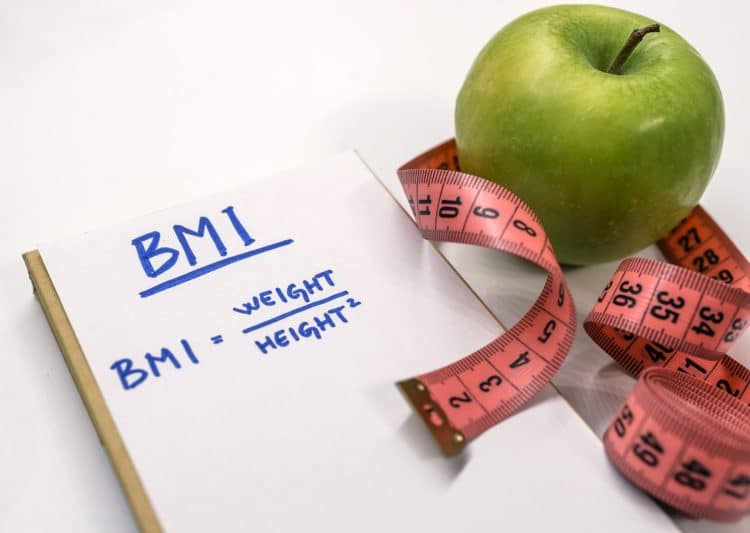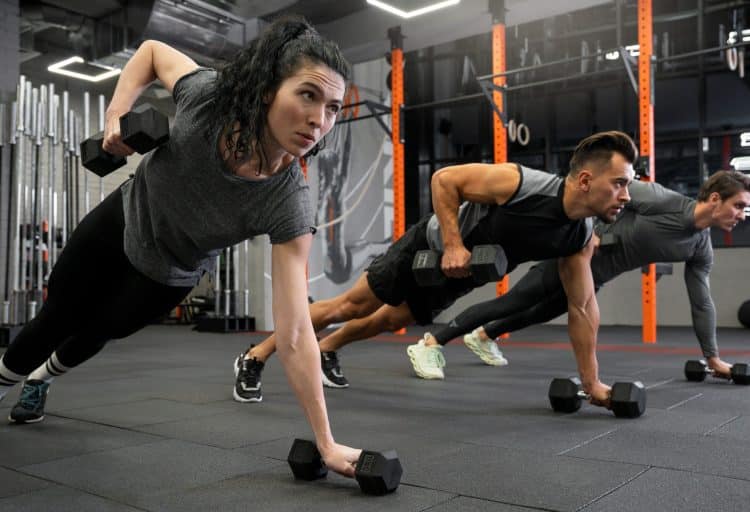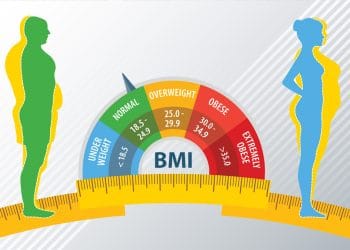In the US, the average BMI varies by age and gender. Men: 26.6, women: 26.5. Both trend higher with age, peaking in the 40-59 range for men and 60+ for women. See age breakdowns in the sections below for specifics. (1)
Introduction
Alright, team, gather around for a body composition breakdown like no other.
You know those numbers that dance on the scale, the ones doctors throw around during checkups?
Yeah, that three-letter acronym — BMI — it’s got a story to tell, and let me tell you, it’s got some twists and turns.
Buckle up because we’re about to chart the fascinating and sometimes surprising landscape of American body mass by age and gender.
Remember the days when “overweight” felt like a distant term, reserved for a select few struggling with dessert portions?
Level Up Your Fitness: Join our 💪 strong community in Fitness Volt Newsletter. Get daily inspiration, expert-backed workouts, nutrition tips, the latest in strength sports, and the support you need to reach your goals. Subscribe for free!
Well, fast forward a couple of decades, and that picture’s flipped.
Today, nearly half of American adults wear the “overweight” or “obese” label, with the average BMI steadily creeping up like a rogue vine on a trellis.
But here’s the kicker: it’s not a uniform climb. This weight-gain waltz has distinct steps for different ages and genders, leaving some groups twirling faster than others.
Average BMI of Americans by Age and Gender
Alright, folks, let’s crack open the treasure chest of BMI data and see what gems we can unearth about American bodies across the age spectrum.
We’ll be splitting this analysis into two camps: Men on Mission Muscle and Women Who Slay Scales. Buckle up because this is where things get interesting! (1)
Men on Mission Muscle:
20-29: Peak Performance Playground
The young bucks boast the lowest average BMI, hovering around 27.6. Peak metabolism, active lifestyles, and a hefty dose of testosterone paint a picture of lean, mean, muscle machines.
This isn’t a free pass for pizza marathons, though. Remember, BMI doesn’t tell the whole story — muscle mass plays a big role here.
30-39: The Crossroads of Commitment
Here’s where things get nuanced. Careers climb, families sprout, and sleep shrinks. Average BMI creeps up to 30.3, reflecting the tug-of-war between adult responsibilities and gym time.
Prioritizing healthy habits becomes crucial to maintain that youthful physique.
40-49: The Dad Bod Dilemma
Ah, the infamous dad bod. Average BMI settles comfortably around 30.1, and let’s be honest, the six-pack might be replaced by a keg (of responsibilities, of course).
Metabolism slows down, and fatherhood fatigue is real. But fear not, papas! Smart nutrition and consistent exercise can still sculpt a strong, healthy body at this stage.
50-59 Silverbacks on the Prowl
Don’t underestimate the Silverbacks. The average BMI lowers to 29.8. These seasoned vets pack years of wisdom (and maybe a few extra pounds). But it’s all about body composition!
Maintaining muscle mass through strength training and focusing on overall health keeps these Silverbacks agile and vibrant.
Women Who Slay Scales:
20-29: Blossoming Beauties
Similar to their male counterparts, young women rock an average BMI of 28.3. Hormonal fluctuations and body image struggles can be prevalent, but prioritizing fitness and balanced nutrition sets the stage for a healthy relationship with their bodies.
30-39: Building Balanced Bodies
Life gets real for these women — careers soar, families form, and the pressure to “have it all” intensifies. The average BMI rises to 29.9, reflecting the juggling act of motherhood, work, and self-care.
Finding time for movement and mindful eating becomes key to maintaining a healthy balance.
40-49: Fierce and Fabulous Forties
These queens own their power! The average BMI settles around 30.7, but don’t be fooled by the rising BMI numbers. These women are often at their peak of strength, confidence, and self-awareness.
Embracing a holistic approach to health, with a focus on both physical and mental well-being, keeps them glowing from within.
50-59 Wise Women Warriors
These women are the definition of resilience! The average BMI slides to 30.3. Prioritizing bone health, managing stress, and staying active keeps them vibrant and ready to tackle anything.
Calculate your body mass index using our BMI calculator.
Here are the five BMI categories to assess your fat mass:
- Underweight: <18.5
- Normal weight: 18.5 – 24.9
- Overweight: 25 – 29.9
- Obesity: 30 – 34.9
- Extreme Obesity: BMI of 35 or greater
Related: BMI Chart for Men and Women: Learn If Your Weight is Healthy
What is BMI?
BMI, or Body Mass Index, is a handy formula that spits out a number based on weight and height.
It’s not perfect, mind you. Like a one-size-fits-all T-shirt, it doesn’t account for the individual muscle mass, bone density, and even your unique body frame.
But hear me out — it’s still a decent first cue, a red flag waving when things might be tipping out of balance.
Think of it this way: a high BMI can lead to chronic health conditions like heart disease, diabetes, and even certain cancers. So, understanding how this number jives with age and gender becomes crucial, not just for individuals but for public health as a whole. (2)
A study published in the Journal of Biosocial Science found that overweight and obesity in US children and adolescents are associated with negative effects on skills formation, with potential improvements depending on interventions targeting overall health or specific dietary and exercise behaviors. (3)

Unveiling the BMI Tapestry
Now, the juicy stuff.
We pirouetted through age groups, observing how the average American’s weight changes with each passing decade.
Level Up Your Fitness: Join our 💪 strong community in Fitness Volt Newsletter. Get daily inspiration, expert-backed workouts, nutrition tips, the latest in strength sports, and the support you need to reach your goals. Subscribe for free!
We did a two-step with gender, unmasking the disparities between men and women in this weight-management tango.
Next, we’ll sift through the evidence, exploring potential reasons behind these intriguing trends.
Is it our changing relationship with food? Are we shifting to a sedentary lifestyle? Or maybe, just maybe, there’s more to the story than meets the eye, with cultural nuances and socioeconomic factors adding complexity to the mix.
So, grab your curiosity cap and a healthy dose of skepticism because in this article, we’re not just crunching numbers — we’re deconstructing a cultural phenomenon, one BMI beat at a time.
Regional Variations: A Patchwork of Patterns
Before we paint the whole country with the same brush, let’s acknowledge that regional variations exist. Factors like socioeconomic status, cultural influences, and access to healthy resources can all shape average BMIs across different states.
For example, coastal states tend to have slightly lower average BMIs than inland ones, often due to factors like access to fresh produce and a culture of outdoor activity.
Remember, those average BMIs are just floating lighthouses in a vast ocean of diverse bodies. Each of us is a unique island, shaped by genetics, personal history, and the currents of our daily lives.
So, while the average 20-something woman might hover around 27-28 BMI, there’s a beautiful spectrum within that range. Some ladies might naturally carry more muscle, pushing the scale higher, while others might be naturally leaner. And that’s okay.
The key is to ditch the cookie-cutter comparisons and embrace your body.
Do you have gazelle-like legs and a powerful torso? Celebrate your athletic prowess. Are your curves more like rolling hills than flat plains? Own that feminine strength.
Every body has its own story to tell, its strengths, and quirks to love. So, focus on nurturing your health and honoring your unique biomechanics, not chasing some arbitrary number on a chart.
Factors Influencing Age-Related BMI Trends: A Trainer’s Take
Alright, folks, it’s time to dissect the fascinating dance between age and that three-letter acronym everyone loves to hate: BMI.
As your friendly neighborhood trainer with more experience than a gym rat with a lifetime membership, I’ve seen firsthand how weight ebbs and flows through the decades.
But hey, before we chalk it all up to birthday candles and the gravitational pull of cake, let’s break down the real players influencing age-related BMI trends.
1. Hormones
Picture your body as a finely tuned orchestra, and your hormones are the conductors. Now, imagine those conductors getting swept up in a temporal tango, their tempos and rhythms changing with each passing year. That’s what happens as we age.
- Estrogen and Testosterone: Say goodbye to your teenage metabolic furnace. As estrogen dips in women and testosterone takes a tumble in men, our bodies become less efficient at burning calories. Think of it like trading in a Ferrari for a fuel-efficient Prius — slower burn, more storage potential.
- Thyroid Twists: This little butterfly gland plays a significant role in metabolism, and guess what? It can get sluggish with age, too. A sluggish thyroid means a sluggish calorie burn, which can lead to a gradual creep up the BMI scale.
- Stress Hormones: Life throws curveballs, and our bodies respond with cortisol, the “fight-or-flight” hormone. Chronic stress, however, keeps that cortisol pumping, leading to increased abdominal fat storage — not the six-pack kind.
2. Lifestyle
Let’s face it: life gets busy. Work deadlines, family demands, Netflix binges — they all chip away at our precious time and energy, often leaving us with less motivation (and fewer hours) to prioritize healthy habits.
- Diet Dilemmas: Swapping home-cooked meals for takeout and late-night snacks becomes more tempting as responsibilities pile up. Portions creep up, sugary treats call our names, and suddenly, that balanced plate feels like a distant memory.
- Physical Fades: Remember those high school days of endless energy and spontaneous gym sessions? Yeah, those can fade faster than a New Year’s resolution. Reduced physical activity due to injury, time constraints, or plain old fatigue can send our calorie expenditure into a nosedive.
- Sleep Snoozes: Sleep isn’t just for beauty queens; it’s crucial for regulating hormones and metabolism. Chronic sleep deprivation throws off our internal clock, messing with hunger cues and cravings and making it harder to resist that extra slice of cake (because who needs REM sleep when you have delicious carbs, right?).
3. Socioeconomic Symphonies
Let’s be real; not everyone has the same instruments in their life orchestra. Some have access to fresh groceries and fitness centers, while others juggle multiple jobs and food deserts. These stark contrasts play a major role in shaping BMI trends across different demographics.
- Income Inequalities: Access to healthy food, safe neighborhoods for exercise, and quality healthcare can be a luxury for low-income individuals. Processed, calorie-dense foods often become the cheaper, more readily available option, impacting dietary choices and BMI.
- Education Echoes: Higher education levels are often linked to better health literacy and awareness of healthy lifestyle choices. This knowledge translates into making informed decisions about diet, exercise, and overall well-being, influencing BMI trends.
- Healthcare Harmonies: Access to healthcare isn’t just about treating existing conditions; it’s about prevention and education. Regular check-ups, personalized guidance from healthcare professionals, and access to resources can empower individuals to manage their weight and health proactively, impacting BMI across different socioeconomic groups.
So, there you have it, folks! The age-related BMI tango isn’t just about ticking clocks and birthday cake. It’s a complex interplay of hormonal shifts, lifestyle choices, and the socioeconomic realities that shape our lives.
Remember, understanding these factors isn’t about finger-pointing; it’s about empowering ourselves and each other to make informed choices and navigate the weight-management maze with a little more understanding and a lot less judgment.
Implications and Considerations: Beyond the Numbers
Alright, folks, let’s talk real here. We’ve crunched the numbers, dissected the data, and stared down the average BMI of Americans by age and gender.
Now, the real work begins: understanding what it all means and carving a path toward optimal health far beyond the confines of a single statistic.
Myth Busters: Debunking the BMI Misinformation Machine
First things first, let’s clear the air of some misconceptions buzzing around this whole BMI business.
Think of it as a trusty barometer, giving you a general sense of atmospheric pressure. But just like you wouldn’t base your entire picnic plan solely on that reading, relying solely on BMI for your health assessment is a recipe for disappointment.
Here’s an overview:
- Muscle matters: BMI doesn’t differentiate between lean muscle mass and flabby fat tissue. So, a ripped athlete sporting a hefty muscle load might technically fall into the “overweight” category, while a couch potato with jiggly bits could wiggle into the “normal” range. Not exactly fair, right?
- Genetics play a hand: Some folks are naturally built thicker than others, thanks to the genetic lottery. Don’t get caught up in a comparison game based on an average that might not even apply to your unique body blueprint.
- Age is just a number (but it does matter): As we age, our body composition naturally shifts. What was considered a “healthy” BMI in your 20s might not be the same story in your 50s.
Beyond the Average: Your Health Story Is Yours to Write
Understanding average BMI trends is like reading the headlines — informative but hardly the whole story.
To truly grasp your health picture, you need to zoom in, past the blurry national averages, and focus on the unique factors shaping your own journey.
Think of it like this: imagine your health as a vibrant masterpiece. Sure, the average BMI paints the background, but the truly impactful details come from your personal brushstrokes.
Are you getting enough sleep? Nourishing your body with real food? Moving your magnificent body? These are the elements that truly define your individual health canvas.
Shifting Gears: From Numbers to Habits
Alright, here’s the golden nugget: obsessing over hitting a specific BMI number is like chasing a mirage in the desert. Instead, let’s shift gears and focus on cultivating healthy habits that nourish your body and soul from the inside out.
Picture this: instead of staring at a scale, you wake up energized, ready to tackle the day with a morning jog. Instead of counting calories, you fill your plate with colorful veggies and protein-packed goodness. Instead of dreading the gym, you discover the joy of movement, whether it’s dancing like nobody’s watching or conquering a challenging yoga pose.
These are the habits that truly build a foundation for sustainable health and well-being. They’re not about reaching a magic number but crafting a vibrant life filled with movement, mindful eating, and overall well-being.
Remember, folks, the average BMI is just one data point in your magnificent health odyssey. Don’t get lost in the numbers game. Focus on the habits that fuel your unique journey, and watch your personal health masterpiece come to life, stroke by glorious stroke.
Conclusion
We’ve navigated the intricate stats, revealing how age-gender-BMI play out — women generally clocking in with lower BMIs, men catching up later, and both sexes facing an uphill battle as the birthday candles pile up.
But remember, BMI is just the tip of the iceberg. Muscle mass, bone density, and individual body composition all influence the bigger picture of health. Celebrate its strengths, nurture its potential, and treat it with respect. Ditch the self-flagellation and replace it with self-compassion.
This isn’t a sprint; it’s a marathon of self-discovery. There will be stumbles and setbacks, but that’s okay.
If you have any questions about BMI, drop them in the comments below, and I’ll be happy to help.
References
- Centers for Disease Control and Prevention. Anthropometric Reference Data for Children and Adults: United States, 2015-2018. National Center for Health Statistics. Hyattsville, MD. 2021. Accessed 15 Jan 2024. https://www.cdc.gov/nchs/data/series/sr_03/sr03-046-508.pdf
- Shah H, Mali S, Ranga S, Jadhav C, Rukadikar A, Singh AK, Shamnani G. Effect of body mass index on cardiorespiratory parameters among medical students: a cross-sectional study. Int J Physiol Pathophysiol Pharmacol. 2022 Feb 15;14(1):4-9. PMID: 35310861; PMCID: PMC8918606.
- Murasko JE. OVERWEIGHT/OBESITY AND HUMAN CAPITAL FORMATION FROM INFANCY TO ADOLESCENCE: EVIDENCE FROM TWO LARGE US COHORTS. J Biosoc Sci. 2015 Mar;47(2):220-37. doi: 10.1017/S0021932014000236. Epub 2014 Jun 16. PMID: 24933426.
Article Updates Timeline:
Our editorial team experts constantly update the articles with new information & research, ensuring you always have access to the latest and most reliable information.
January 17, 2024
Written By
Vidur Saini
Edited By
Editorial Team
Fact Checked By
Dr. Malik











